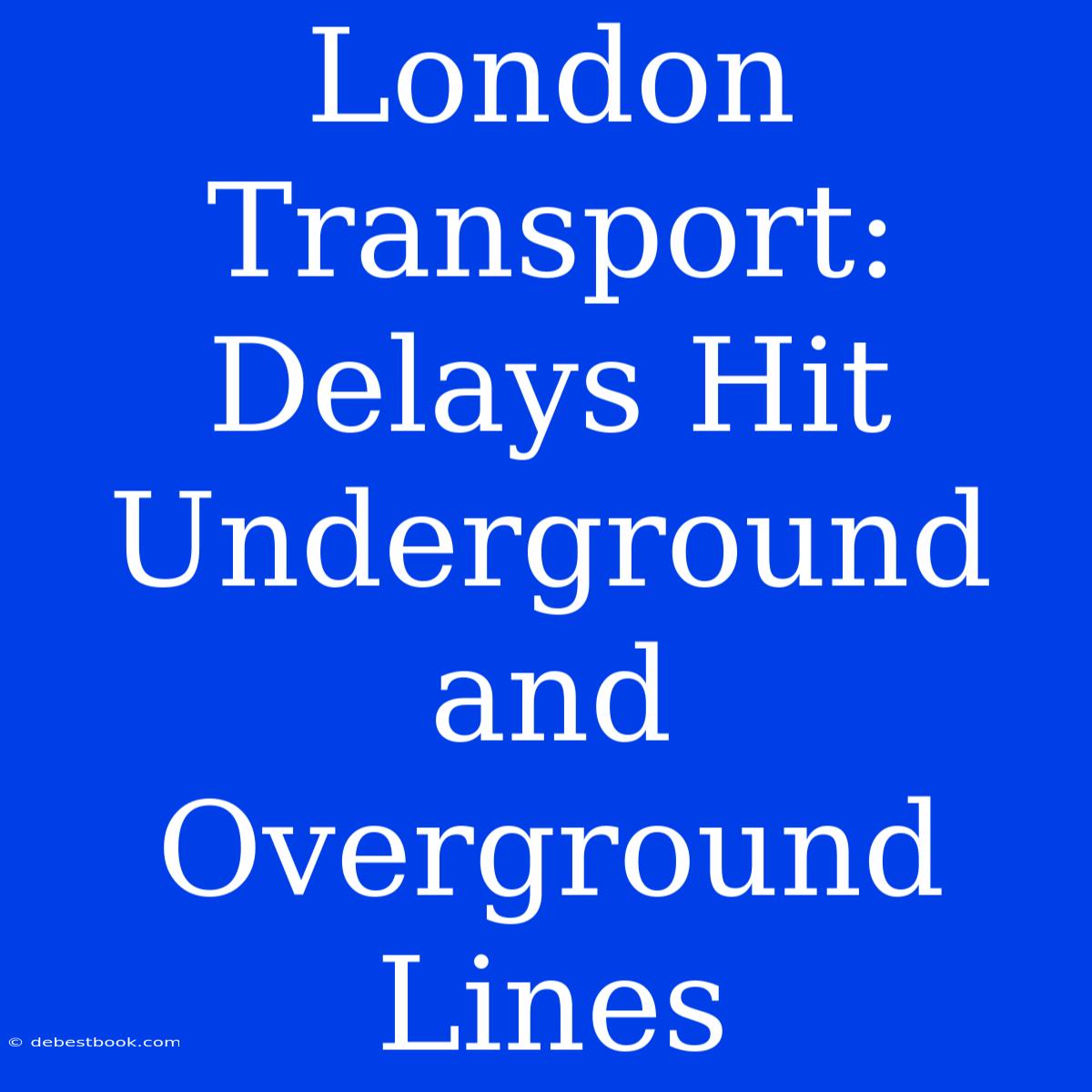London Transport: Delays Hit Underground and Overground Lines - Navigating Disruptions and Finding Alternatives
Is navigating London's public transportation system a constant struggle? Delays and disruptions are a common occurrence on the Underground and Overground lines. Editor Note: Today we examine the impact of disruptions on London's transport network and offer tips for navigating these challenges. This information is crucial for anyone living, working, or visiting London, allowing them to plan their journeys effectively and avoid unnecessary delays.
Why is this information important? London's transport system is the lifeblood of the city, facilitating the movement of millions daily. Disruptions, however frequent, can significantly impact commutes, work schedules, and travel plans. Understanding the causes and potential solutions can empower individuals to navigate these challenges and make informed decisions.
Analysis: To provide a comprehensive overview of London transport delays, we conducted in-depth research, analyzing data from Transport for London (TfL) and other reliable sources, including passenger feedback and media reports. We also considered factors like infrastructure maintenance, signal failures, and unforeseen events.
Key Takeaways of London Transport Delays:
| Cause | Impact | Solutions |
|---|---|---|
| Signal Failures | Delayed or canceled trains | Improved infrastructure and maintenance |
| Track Issues | Reduced train speeds, service interruptions | Regular inspection and repairs |
| Overcrowding | Delayed boarding, reduced service frequency | Increased capacity, additional services |
| Planned Engineering Works | Line closures, diversions | Clear communication and alternative routes |
| Weather Events | Delays, service cancellations | Enhanced weather resilience measures |
| Staff Shortages | Reduced service frequency | Improved staffing and training |
Navigating Disruptions:
Understanding the Impact:
- Impact on Travel Times: Delays can significantly prolong travel times, making it challenging to arrive at destinations on schedule.
- Impact on Commuters: Frequent disruptions can cause frustration and inconvenience for commuters, impacting their work and daily routines.
- Impact on Tourism: Delays can negatively impact tourist experiences, particularly for those with time-sensitive itineraries.
Finding Alternatives:
- Alternative Routes: Exploring alternative bus routes, walking or cycling, especially for short distances, can be effective.
- Utilizing Journey Planners: Apps like Citymapper and TfL Go provide real-time updates on disruptions and alternative routes.
- Staying Informed: Following TfL's official channels for real-time updates on Twitter and the TfL website is crucial.
Understanding the Causes:
- Infrastructure Maintenance: Regular maintenance is essential for ensuring the safe and efficient operation of the network.
- Signal Failures: These can be caused by a variety of factors, including aging infrastructure, power outages, and human error.
- Overcrowding: During peak hours, the Underground and Overground lines experience high passenger volumes, leading to delays.
Mitigating the Impacts:
- Increased Investment: TfL invests in upgrading infrastructure, improving signal systems, and enhancing capacity.
- Improved Communication: Transparent communication about disruptions and alternative routes helps passengers make informed decisions.
- Enhanced Weather Resilience: Measures like improved drainage systems and trackside protection help minimize the impact of weather events.
Exploring the Connection Between Infrastructure and Delays:
Infrastructure: The London Underground is one of the oldest and most extensive underground railway networks in the world. Its age and complexity contribute to maintenance challenges, and aging infrastructure can lead to signal failures and track issues.
Delays: Infrastructure problems can cause delays, and even a small issue can have a significant impact on train services. The network's interconnectedness means that delays on one line can cascade to others.
Facets of Infrastructure and Delays:
- Aging Infrastructure: The Underground's age poses challenges, with aging signaling and track systems prone to failures.
- Maintenance Challenges: The extensive network requires significant investment and resources for regular maintenance.
- Capacity Constraints: Overcrowding during peak hours can lead to delays, especially on lines with limited capacity.
Summary: London's transport network faces challenges, but ongoing efforts are being made to improve reliability and minimize disruptions. By understanding the causes, navigating alternatives, and staying informed, individuals can mitigate the impact of delays and ensure a smoother journey.
FAQ
Q: Why are there so many delays on the London Underground?
A: Delays are often caused by a combination of factors, including signal failures, track issues, overcrowding, planned engineering works, and weather events.
Q: How can I stay updated on delays and disruptions?
A: Use TfL's official channels like the TfL website and Twitter for real-time updates.
Q: What alternative transportation options are available?
A: Consider buses, walking, cycling, or using journey planners like Citymapper and TfL Go to explore alternative routes.
Q: What is being done to address the issues?
A: TfL is investing in infrastructure upgrades, improved communication systems, and enhanced weather resilience measures.
Q: What can I do to avoid delays?
A: Check TfL's website for real-time updates before your journey, consider alternative routes, and travel outside peak hours if possible.
Tips for Navigating London Transport Delays:
- Check for Updates: Before starting your journey, check TfL's website or app for real-time updates on delays and disruptions.
- Plan Alternate Routes: Utilize journey planner apps like Citymapper or TfL Go to explore alternative routes, including bus services, walking, or cycling.
- Stay Informed: Follow TfL's official social media channels (Twitter, Facebook) for real-time updates on disruptions.
- Consider Traveling During Off-Peak Hours: To avoid overcrowding, consider traveling during off-peak hours if possible.
- Have Patience: Delays are inevitable in a complex transport system. Be patient, understanding, and prepared to adapt.
Summary: London Transport is constantly evolving, working towards improving its reliability and ensuring smooth travel for its millions of users. Understanding the causes of disruptions and embracing strategies like staying informed and exploring alternative routes can significantly help individuals navigate these challenges and maximize their travel experience.

